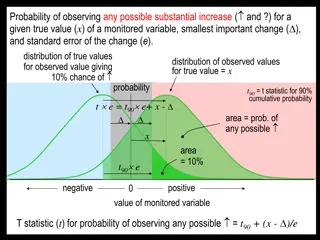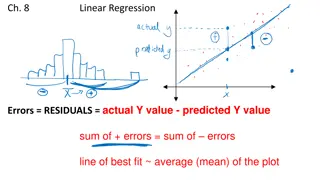
Understanding Research Variables and Types
Explore the concept of research variables, including dependent and independent variables, quantitative and qualitative variables, and the different types of variable scales like nominal and ordinal. Learn how variables are categorized and utilized in research studies.
Download Presentation

Please find below an Image/Link to download the presentation.
The content on the website is provided AS IS for your information and personal use only. It may not be sold, licensed, or shared on other websites without obtaining consent from the author. If you encounter any issues during the download, it is possible that the publisher has removed the file from their server.
You are allowed to download the files provided on this website for personal or commercial use, subject to the condition that they are used lawfully. All files are the property of their respective owners.
The content on the website is provided AS IS for your information and personal use only. It may not be sold, licensed, or shared on other websites without obtaining consent from the author.
E N D
Presentation Transcript
Variable is a concept that varies. It can be quantity, intensity, amount and types. It takes two or more values. Variable is a measurable characteristics that varies. It may change from group to group, person to person or within person over time. In research science, variable refer to factor or condition that can change during the course of an experiment. Thus, variable is anything that may assume different numerical and categorical values. Eg: Gender is a variable it can be two values male and female Marital status is variable it can be unmarried, widowed, divorced. Types of variables: 1. Dependent and Independent Variables 2. Quantitative and Qualitative Variables 3. Continuous and Discontinuous Variables 4. Demographic Variables 5. Extraneous Variables 6. Control Variables
Independent variables: which are manipulated or controlled or changed. It is what the researcher studies to see its relationship or effects . Presumed or possible cause. Dependent variables : are the outcome variables and are the variables for which we calculate statistics. The variable which changes on account of independent variable is known as dependent variable. It is influenced or affected by independent variable. Presumed results(effect) Eg; A comparative study of the professional attitudes of secondary school teachers by gender. Independent variable is Gender of teacher male or female Dependent variable is score on a professional attitude inventory. Quantitative variable are ones that exist along a continum that runs from low to high. Interval and ratio variables are quantitative. Quantitative variables are sometimes called continuous variable because they have a variety of characteristics. Eg height in inches, scores on test.
Qualitative variables do not express difference in amount. They are referred to as categorical variables because they classify by categories. Ordinal, Nominal variable. Nominal variable such as gender, religion, or eye color are categorical variables. Nominal Scale, also called the categorical variable scale, is defined as a scale used for labeling variables into distinct classifications and doesn't involve a quantitative value or order. This scale is the simplest of the four variable measurement scales. Gender Political preferences Place of residence What is your Gender M- Male F- Female What is your Political preference? 1- Independent 2- Democrat 3- Republican Where do you live? 1- Suburbs 2- City 3- Town
Ordinal Scale is defined as a variable measurement scale used to simply depict the order of variables(what's important and significant) and not the difference between each of the variables(differences between each one is not really known)* For example, is the difference between "OK" and "Unhappy" the same as the difference between Very Happy" and "Happy?" We can't say. Ordinal scales are typically measures of non-numeric concepts like satisfaction, happiness, discomfort, etc. Ordinal is easy to remember because is sounds like "order" and that's the key to remember with "ordinal scales"-it is the order that matters Example: On a survey you might code Educational Attainment as 0=less than high school; 1=some high school.; 2=high school degree; 3=some college; 4=college degree; 5=post college. In this measure, higher numbers mean more education. But is distance from 0 to 1 same as 3 to 4? Of course not.
Interval Scale is defined as a numerical scale where the order of the variables is known as well as the difference between these variables. Variables which have familiar, constant and computable differences are classified using the Interval scale. Interval scale contains all the properties of ordinal scale, in addition to which, it offers a calculation of the difference between variables. The main characteristic of this scale is the equidistant difference between objects. In statistics, interval scale is frequently used as a numerical value can not only be assigned to variables but calculation on the basis of those values can also be carried out. Calendar years and time also fall under this category of measurement scales. Likert scale is the most-used interval scale examples.
Ratio Scale is defined as a variable measurement scale that not only produces the order of variables but also makes the difference between variables known along with information on the value of true zero. It is calculated by assuming that the variables have an option for zero, the difference between the two variables is the same and there is a specific order between the options. In addition to the fact that the ratio scale does everything that a nominal, ordinal and interval scale can do, it can also establish the value of absolute zero. Examples The following questions fall under the Ratio Scale category: What is your daughter's current height?- Less than 5 feet. -5 feet 1 inch - 5 feet 5 inches What is your weight in kilograms?- Less than 50 kilograms -51-70 kilograms -71-90 kilograms
Continuous and Discontinuous Variables If the values of a variable can be divided into fractions then we call it a continuous variable. Such a variable can take infinite number of values. Income, temperature, age, or a test score are examples of continuous variables. These variables may take on values within a given range or, in some cases, an infinite set. Any variable that has a limited number of distinct values and which cannot be divided into fractions, is a discontinuous variable. Such a variable is also called as categorical variable or classificatory variable, or discrete variable. Some variables have only two values, reflecting the presence or absence of a property: employed-unemployed or male-female have two values. These variables are referred to as dichotomous. There are others that can take added categories such as the demographic variables of race, religion. All such variables that produce data that fit into categories are said to be discrete/categorical/classificatory, since only certain values are possible.
VARIABLES EXAMPLES Examples Gender: Male and female Variables Type of property: Commercial and residential Pregnant and non pregnant Alive and dead HIV positive and HIV negative Education: Literate and illiterate o Residence: Urban, semi urban and rural Variables o Religion: Hindu, muslim, and Christianity. Blood groups: A,B,AB and O 1. 2. Dichotomous Trichotomous Multiple Variables 3.
DEMOGRAPHIC VARIABLES: "Demographic variables are characteristics or attributes of subjects that are collected to describe the sample". They are also called sample characteristics. It means these variables describe study sample and determine if samples are representative of the population of interest. Although demographic variables cannot be manipulated, "researchers can explain relationships between demographic variables and dependent variables. Some common demographic variables are age, gender, occupation, marital status, income etc. Extraneous variable It happens sometimes that after completion of the study we wonder that the actual result is not what we expected. In spite of taking all the possible measures the outcome is unexpected. It is because of extraneous variables. Variables that may affect research outcomes but have not been adequately considered in the study are termed as extraneous variables. Extraneous variables exist in all studies and can affect the measurement of study variables and the relationship among these variables.
Extraneous variables that are not recognized until the study is in process, or are recognized before the study is initiated but cannot be controlled, are referred to as confounding variables. These variables interferes the results of the existing activity. Certain external variables may influence the relationship between the research variables, even though researcher cannot see it. These variables are called intervening variables. Control Variable Sometimes certain characteristics of the objects under scrutiny are deliberately left unchanged. These are known as constant or controlled variables. The variables that are not measured in a particular study must be held constant, neutralized/balanced, or eliminated, so they will not have a biasing effect on the other variables. In the ice cube experiment, one constant or controllable variable could be the size and shape of the cube. By keeping the ice cubes' sizes and shapes the same, it's easier to measure the differences between the cubes as they melt after shifting their positions, as they all started out as the same size.
THANK YOU






















